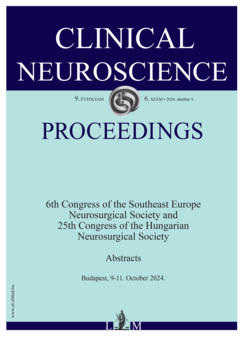Use of AI in the process of designing tailored cranial implants From CT to 3D printing
TICHOV Fruzsina1, VITANOVIC Dusan2
2024. OKTÓBER 09.
Ideggyógyászati Szemle Proceedings - 2024;9(6)
TICHOV Fruzsina1, VITANOVIC Dusan2
2024. OKTÓBER 09.
Ideggyógyászati Szemle Proceedings - 2024;9(6)
Szöveg nagyítása:

Recently, artificial intelligence (AI) has been used explosively in different areas of life. Such softwares plays an increasingly important role in the field of medicine also. They proved to be particularly suitable for replacing repetitive work. The design and programming of cranial and craniofacial implants in addition to creativity (designer) demand a large amount of repetitive work/movements. Therefore, artificial intelligence is excellently suited for replacing current lengthy work processes. AI is capable of reducing the current implant design process, which may consist of hundreds of steps, to as few as 10 steps (e.g. Geomagic Freeform Plus). The design of simpler implants (not large surface area, single-plane) does not require human intervention, but the finalization of complex craniofacial implants involving multiple areas require human involvement.
In summary we can say that AI is capable of greatly simplifying the previously complex and time-consumung process of designing custom implants, but it currently cannot replace human involvement.
Ideggyógyászati Szemle Proceedings
Despite evidence based institutional protocols being in place in many countries, aneurysmal subarachnoid hemorrhage (SAH) continues to be a major socio-economic burden with many open questions remaining regarding the optimal management of the affected patients.
Ideggyógyászati Szemle Proceedings
Arteriovenous malformation (AVM) is an anomaly of blood vessel formation. Numerous models have been established to understand the nature of AVM.
Ideggyógyászati Szemle Proceedings
Additive manufacturing has gained significant traction in industrial applications due to its high potential when it comes to manufacturing objects with complex geometry.
Ideggyógyászati Szemle Proceedings
Not only other surgical and robotic fields, but minimally invasive procedures in spine surgery have undergone significant development in recent times. A demand emerged from both surgeons and patients to develop and perform these types of surgeries in order to prevent biomechanical and surgical complications.
Ideggyógyászati Szemle Proceedings
Tumors in and around brain stem remain one of the biggest neurosurgical challenges due to com- plex anatomy of this “high valued real estate area.
Hypertonia és Nephrologia
Az idő függvényében észlelt változékonysága a vérnyomás-variabilitás, amelyet szervezeten belüli szabályozómechanizmusok és a szervezetre ható környezeti tényezők egyaránt befolyásolnak. Több formája ismeretes, attól függően, hogy a változékonyság milyen időtartam során figyelhető meg. Klinikai megfigyelések, nagy epidemiológiai vizsgálatok arra utalnak, hogy a kórosan nagy vérnyomás-variabilitás fokozott cardiovascularis kockázatot hordoz.
Lege Artis Medicinae
Az egészségügyi ellátás során óriási mennyiségű adat keletkezik, ugyanakkor az elmúlt években a nagy adatbázisok feldolgozása terén is óriási előrelépés történt a mesterséges intelligencia technológiai fejlődésével.
Ideggyógyászati Szemle Proceedings
Additive manufacturing has gained significant traction in industrial applications due to its high potential when it comes to manufacturing objects with complex geometry.
Ideggyógyászati Szemle Proceedings
The solitary osseous plasmacytoma (SOP) is a rare bone tumor characterized by the monoclonal proliferation of malignant plasma cells without systemic involvement. We present a case of an 11-year-old patient having a right frontal tumoral mass with a normal neurological exam.
Ideggyógyászati Szemle Proceedings
Since the initial implementation of deep brain stimulation (DBS) for essential tremor by Pollack and Benabid, it has emerged as the gold standard treatment over the past three decades. However, achieving successful outcomes still relies heavily on accurate planning and electrophysiological mapping of the Vim(ventral intermediate nucleus of thalamus).
Introduction of a new 3D printing technology at the point-of-care
The tailored concept in the minimally invasive, transnasal endoscopic surgery
1.
2.
3.
4.
5.
Egészségpolitika
Hadiállapotként kezeli és így is reagál a kormány az egészségügy „rendezésére”1.
2.
Orvoslás és társadalom
Országos férfiegészség-kampány és PSA-szűrés indul a prosztatarák ellen3.
4.
5.